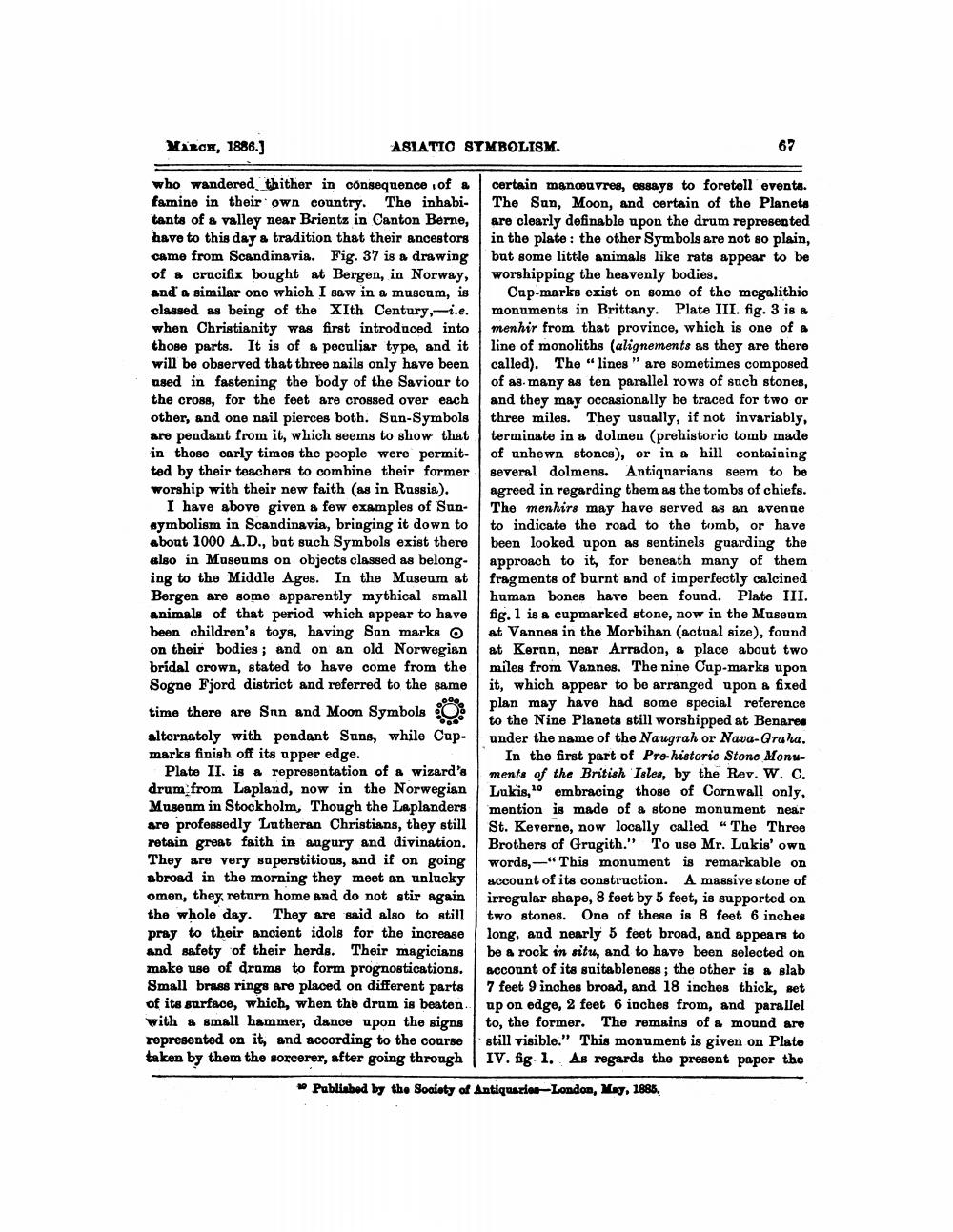________________
MARCH, 1886.J
ASIATIO SYMBOLISM.
617
who wandered thither in consequence of a certain manoeuvres, 688ays to foretell events. famine in their own country. The inhabi- The Sun, Moon, and certain of the Planeta tants of a valley near Brientz in Canton Berne, are clearly definable upon the drum represented have to this day a tradition that their ancestors in the plate: the other Symbols are not so plain, came from Scandinavia. Fig. 37 is a drawing but some little animals like rats appear to be of a crucifix bought at Bergen, in Norway, worshipping the heavenly bodies. and a similar one which I saw in a museum, is Cap-marks exist on some of the megalithic classed as being of the XIth Century,-i.e. monuments in Brittany. Plate III. fig. 3 is & when Christianity was first introduced into menhir from that province, which is one of a those parts. It is of a peculiar type, and it line of monoliths (alignements as they are there will be observed that three nails only have been called). The "lines" are sometimes composed used in fastening the body of the Saviour to of as many as ten parallel rows of such stones, the cross, for the feet are crossed over each and they may occasionally be traced for two or other, and one nail pierces both. Sun-Symbols three miles. They usually, if not invariably, are pendant from it, which seems to show that terminate in a dolmen (prehistoric tomb made in those early times the people were permit. of unbewn stones), or in a hill containing ted by their teachers to combine their former several dolmens. Antiquarians seem to be worship with their new faith (as in Russia). agreed in regarding them as the tombs of chiefs.
I have above given a few examples of Sun- The menhirs may have served as an avenge Aymbolism in Scandinavia, bringing it down to to indicate the road to the tomb, or have about 1000 A.D., bat such Symbols exist there been looked upon as sentinels guarding the also in Museums on objects classed as belong- approach to it, for beneath many of them ing to the Middle Ages. In the Museum at fragments of burnt and of imperfectly calcined Bergen are some apparently mythical small human bones have been found. Plate III. animals of that period which appear to have fig. 1 is a cupmarked stone, now in the Museum been children's toys, having Son marks O at Vannes in the Morbihan (actual size), found on their bodies; and on an old Norwegian at Keran, near Arradon, & place about two bridal crown, stated to have come from the miles from Vannes. The nine Cup-marks upon Sogne Fjord district and referred to the same it, which appear to be arranged upon & fixed time there are Snn and Moon Symbols
plan may have had some special reference
to the Nine Planets still worshipped at Benares alternately with pendant Suns, while Cup- under the name of the Naugrah or Nava-Graha. marks finish off its apper edge.
In the first part of Pre-historic Stone MonuPlate II. is a representation of a wizard's ments of the British Isles, by the Rev. W. C. drum from Lapland, now in the Norwegian Lakis, embracing those of Cornwall only, Mugenm in Stockholm, Though the Laplanders mention is made of a stone monument near are professedly Lutheran Christians, they still St. Keverne, now locally called “ The Three retain great faith in augury and divination. Brothers of Gragith." To use Mr. Lukis' own They are very saperstitions, and if on going words,-“This monument is remarkable on abroad in the morning they meet an unlucky account of its construction. A massive stone of omon, they return home and do not stir again irregular shape, 8 feet by 5 feet, is supported on the whole day. They are said also to still two stones. One of these is 8 feet 6 inches pray to their ancient idols for the increase long, and nearly 5 feet broad, and appears to and safety of their herds. Their magicians be a rock in situ, and to have been selected on make use of drums to form prognostications. account of its suitableness; the other is a slab Small brass rings are placed on different parts 7 feet 9 inches broad, and 18 inches thick, set of its surface, which, when the drum is beaten up on edge, 2 feet 6 inches from, and parallel with a small hammer, dance upon the signs to, the former. The remains of a mound are represented on it, and according to the course still visible." This monument is given on Plate taken by them the sorcerer, after going through IV. fig. 1. As regards tho presont paper the
• Published by the Society of Antiquaria-London, May, 1886.




